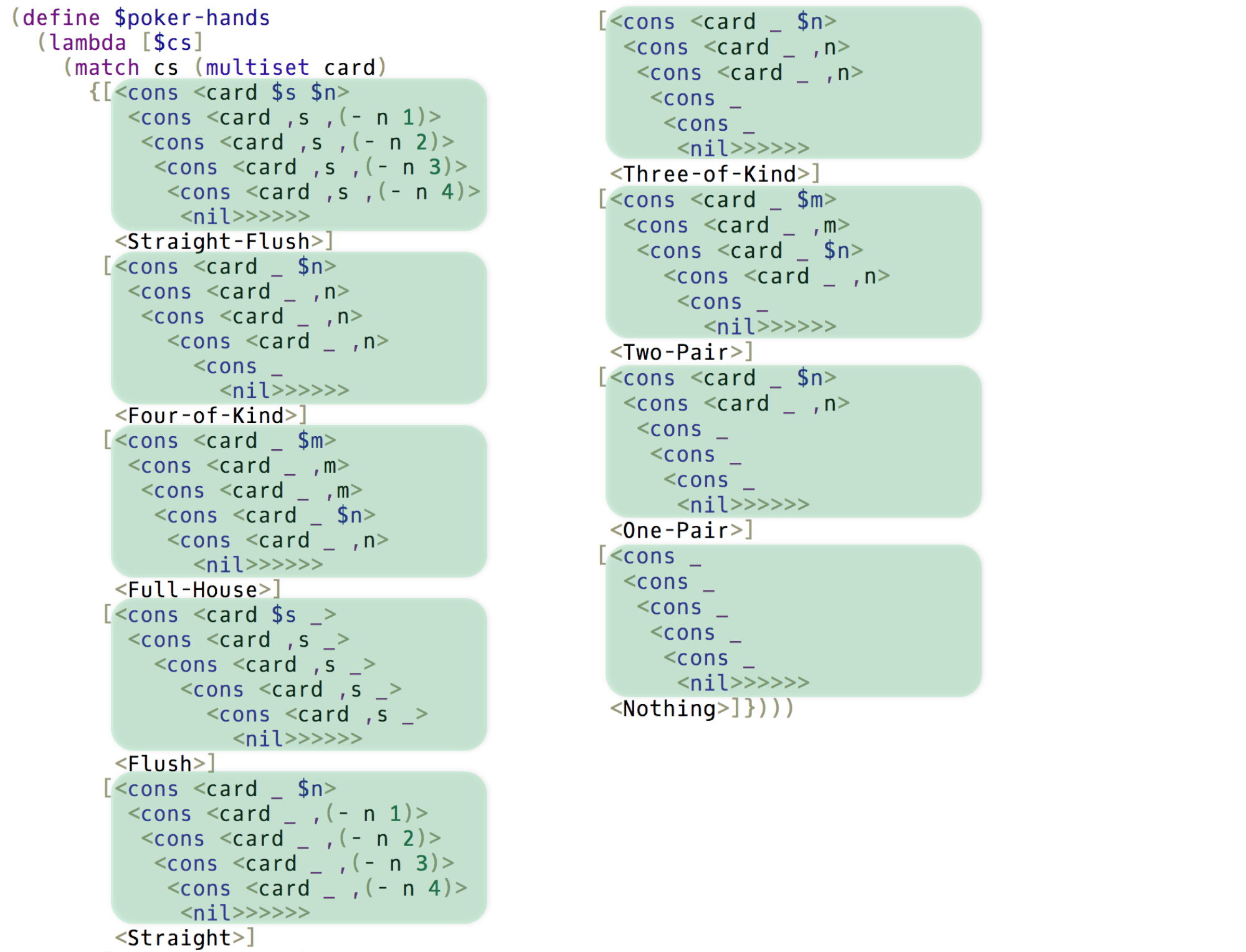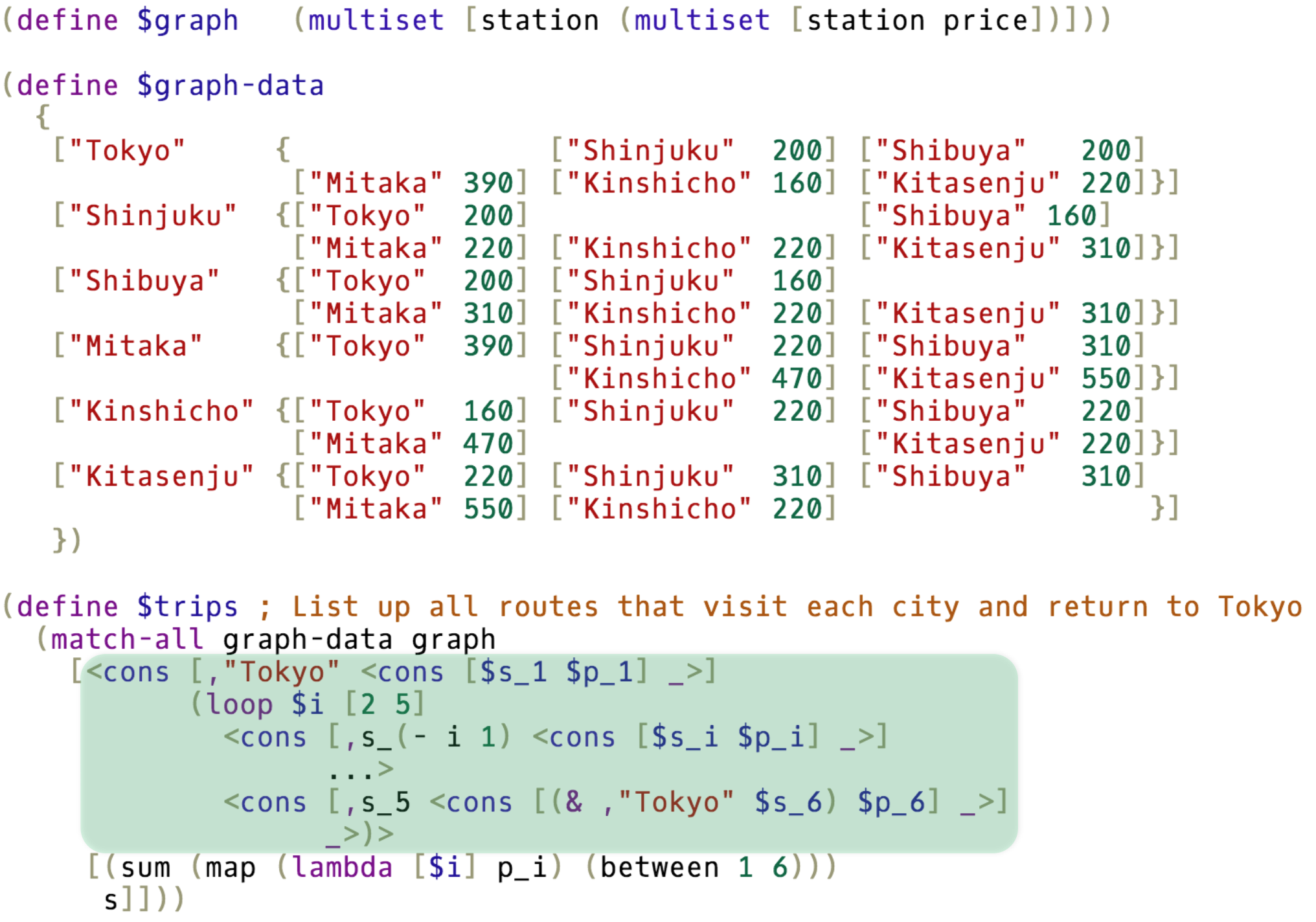Egison is the pattern-matching-oriented, purely functional programming language. We can directly represent pattern-matching against lists, multisets, sets, trees, graphs and any kind of data types. This is the repository of the interpreter of Egison.
For more information, visit our website.
We can do non-linear pattern-matching against non-free data types in Egison. An non-free data type is a data type whose data have no canonical form, a standard way to represent that object. It enables us to write elegant programs.
We can use pattern-matching for enumeration. The following code enumerates all twin primes from the infinite list of prime numbers with pattern-matching!
The following code is the program that determines poker-hands written in Egison. All hands are expressed in a single pattern.
We can write a pattern even against mahjong tiles. We modularize patterns to represent complex mahjong hands.
We can pattern-match against graphs. We can write program to solve the travelling salesman problem in a single pattern-matching expression.
Aren't these exciting? The pattern-matching of Egison is very powerful. We can use it for pattern-matching also against graphs and tree-structures such as XML.
As an application of Egison, we implemented a computer algebra system on Egison. The most part of this computer algebra system is written in Egison and extensible in Egison.
Unbound variables are treated as symbols.
> x
x
> (** (+ x y) 2)
(+ x^2 (* 2 x y) y^2)
> (** (+ x y) 10)
(+ x^10 (* 10 x^9 y) (* 45 x^8 y^2) (* 120 x^7 y^3) (* 210 x^6 y^4) (* 252 x^5 y^5) (* 210 x^4 y^6) (* 120 x^3 y^7) (* 45 x^2 y^8) (* 10 x y^9) y^10)
We can handle algebraic numbers, too.
> (sqrt x)
(sqrt x)
> (sqrt 2)
(sqrt 2)
> (sqrt 4)
2
> (+ x (sqrt y))
(+ x (sqrt y))
The symbol i is defined to rewrite i^2 to -1 in Egison library.
> (* i i)
-1
> (* (+ 1 (* 1 i)) (+ 1 (* 1 i)))
(* 2 i)
> (** (+ 1 (* 1 i)) 10)
(* 32 i)
> (* (+ x (* y i)) (+ x (* y i)))
(+ x^2 (* 2 i x y) (* -1 y^2))
The rewriting rule for sqrt is also defined in Egison library.
> (* (sqrt 2) (sqrt 2))
2
> (* (sqrt 6) (sqrt 10))
(* 2 (sqrt 15))
> (sqrt x)
(sqrt x)
> (* (sqrt (* x y)) (sqrt (* 2 x)))
(* x (sqrt 2) (sqrt y))
The following is a sample to calculate the 5th roots of unity.
> (q-f' 1 1 -1)
[(/ (+ -1 (sqrt 5)) 2) (/ (+ -1 (* -1 (sqrt 5))) 2)]
> (define $t (fst (q-f' 1 1 -1)))
> (q-f' 1 (* -1 t) 1)
[(/ (+ -1 (sqrt 5) (sqrt (+ -10 (* -2 (sqrt 5))))) 4) (/ (+ -1 (sqrt 5) (* -1 (sqrt (+ -10 (* -2 (sqrt 5)))))) 4)]
> (define $z (fst (q-f' 1 (* -1 t) 1)))
> z
(/ (+ -1 (sqrt 5) (sqrt (+ -10 (* -2 (sqrt 5))))) 4)
> (** z 5)
1
We can implement differentiation easily in Egison.
> (d/d (** x 3) x)
(* 3 x^2)
> (d/d (** e (* i x)) x)
(* i (** e (* i x)))
> (d/d (d/d (log x) x) x)
(/ -1 x^2)
> (d/d (* (cos x) (sin x)) x)
(+ (* -1 (sin x)^2) (cos x)^2)
The following sample executes Taylor expansion on Egison. We verify Euler's formula in the following sample.
> (take 8 (taylor-expansion (** e (* i x)) x 0))
{1 (* i x) (/ (* -1 x^2) 2) (/ (* -1 i x^3) 6) (/ x^4 24) (/ (* i x^5) 120) (/ (* -1 x^6) 720) (/ (* -1 i x^7) 5040)}
> (take 8 (taylor-expansion (cos x) x 0))
{1 0 (/ (* -1 x^2) 2) 0 (/ x^4 24) 0 (/ (* -1 x^6) 720) 0}
> (take 8 (taylor-expansion (* i (sin x)) x 0))
{0 (* i x) 0 (/ (* -1 i x^3) 6) 0 (/ (* i x^5) 120) 0 (/ (* -1 i x^7) 5040)}
> (take 8 (map2 + (taylor-expansion (cos x) x 0) (taylor-expansion (* i (sin x)) x 0)))
{1 (* i x) (/ (* -1 x^2) 2) (/ (* -1 i x^3) 6) (/ x^4 24) (/ (* i x^5) 120) (/ (* -1 x^6) 720) (/ (* -1 i x^7) 5040)}
We support tesnsor algebra. We use Einstein notation to express arithmetic operations between tensors.
A tensor is expressed by enclosing its dimensions and elements with (| and |).
(| <dimensions> <elements> |)
> (define $V1 (| {3} {x_1 x_2 x_3} |))
> (define $V2 (| {3} {y_1 y_2 y_3} |))
> (. V1_i V2_i)
(+ (* x_1 y_1) (* x_2 y_2) (* x_3 y_3))
> (. V1_i V2_j)
(| {3 3} {(* x_1 y_1) (* x_1 y_2) (* x_1 y_3) (* x_2 y_1) (* x_2 y_2) (* x_2 y_3) (* x_3 y_1) (* x_3 y_2) (* x_3 y_3)} |)_i_j
> (define $M1 (generate-tensor 2#x_%1_%2 {2 2}))
> (define $M2 (generate-tensor 2#y_%1_%2 {2 2}))
> M1
(| {2 2} {x_1_1 x_1_2 x_2_1 x_2_2} |)
> M2
(| {2 2} {y_1_1 y_1_2 y_2_1 y_2_2} |)
> M1_i_1
(| {2} {x_1_1 x_2_1} |)_i
> M1_1_j
(| {2} {x_1_1 x_1_2} |)_j
> (. M1_i_j M2_j_k)
(| {2 2} {(+ (* x_1_1 y_1_1) (* x_1_2 y_2_1)) (+ (* x_1_1 y_1_2) (* x_1_2 y_2_2)) (+ (* x_2_1 y_1_1) (* x_2_2 y_2_1)) (+ (* x_2_1 y_1_2) (* x_2_2 y_2_2))} |)_i_k
> (. M1_i_j M2_k_l)
(| {2 2 2 2} {(* x_1_1 y_1_1) (* x_1_1 y_1_2) (* x_1_1 y_2_1) (* x_1_1 y_2_2) (* x_1_2 y_1_1) (* x_1_2 y_1_2) (* x_1_2 y_2_1) (* x_1_2 y_2_2) (* x_2_1 y_1_1) (* x_2_1 y_1_2) (* x_2_1 y_2_1) (* x_2_1 y_2_2) (* x_2_2 y_1_1) (* x_2_2 y_1_2) (* x_2_2 y_2_1) (* x_2_2 y_2_2)} |)_i_j_k_l
Addition of tensors and arithmetic between a scalar and a tensor are expressed as follow.
> (define $X (generate-tensor 2#x_%1_%2 {2 2}))
> (define $Y (generate-tensor 2#y_%1_%2 {2 2}))
> X
(| {2 2} {x_1_1 x_1_2 x_2_1 x_2_2} |)
> Y
(| {2 2} {y_1_1 y_1_2 y_2_1 y_2_2} |)
> (T.map2 + X_i_j Y_j_i)
(| {2 2} {(+ x_1_1 y_1_1) (+ x_1_2 y_2_1) (+ x_2_1 y_1_2) (+ x_2_2 y_2_2)} |)_i_j
> (T.+ X 100)
(| {2 2} {(+ x_1_1 100) x_1_2 x_2_1 (+ x_2_2 100)} |)
There are a lot of existing work for pattern-matching.
The advantage of Egison is that it achieves all of the following features at the same time.
- Modularization of the way of pattern-matching for each data type
- Pattern-matching with multiple results (backtracking)
- Non-linear pattern-matching with lexical scoping
- Parametric polymorphism of pattern-constructors
The Pattern-Matching Mechanism section in Egison developer's manual explains how we achieve that.
Please read our paper on arXiv.org for details.
If you are using Linux, please install libncurses-dev at first.
% sudo apt-get install libncurses-dev # on Debian
To compile Egison, you also need to install Haskell Platform.
After you installed Haskell Platform, run the following commands on the terminal.
% cabal update
% cabal install egison
Now, you can try Egison.
% egison
Egison Version X.X.X(C) 2011-2014 Satoshi Egi
http://www.egison.org
Welcome to Egison Interpreter!
> ^D
Leaving Egison Interpreter.
If you are a beginner of Egison, it would be better to install egison-tutorial.
% cabal update
% cabal install egison-tutorial
% egison-tutorial
Egison Tutorial Version 3.3.6 (C) 2013-2014 Satoshi Egi
Welcome to Egison Tutorial!
** Information **
We can use a 'Tab' key to complete keywords on the interpreter.
If we type a 'Tab' key after a closed parenthesis, the next closed parenthesis will be completed.
*****************
==============================
List of sections in the tutorial.
1: Calculate numbers (10 minutes)
2: Basics of functional programming (10 minutes)
3: Basics of pattern-matching (10 minutes)
4: Pattern-matching against infinite collections (5 minutes)
==============================
Choose a section to learn.
(1-4): 1
====================
We can do arithmetic operations with '+', '-', '*', '/', 'modulo' and 'power'.
Examples:
(+ 1 2)
(- 30 15)
(* 10 20)
(/ 20 5)
(modulo 17 4)
(power 2 10)
====================
>
We can try it also online. Enjoy!
% cabal test
% sudo apt-get install haskell-platform-doc haskell-platform-prof
% cabal install --enable-library-profiling --enable-executable-profiling
% egison +RTS -p -RTS -l sample/sequence.egi
% cat egison.prof
We have a mailing list. Please join us!
We are on Twitter. Please follow us.
I thank Ryo Tanaka, Takahisa Watanabe, Takuya Kuwahara and Kentaro Honda for their help to implement the interpreter.
Copyright (c) 2011-2016, Satoshi Egi
Egison is released under the MIT license.
I used husk-scheme by Justin Ethier as reference to implement the base part of the previous version of the interpreter.
Egison is sponsored by Rakuten, Inc. and Rakuten Institute of Technology.



